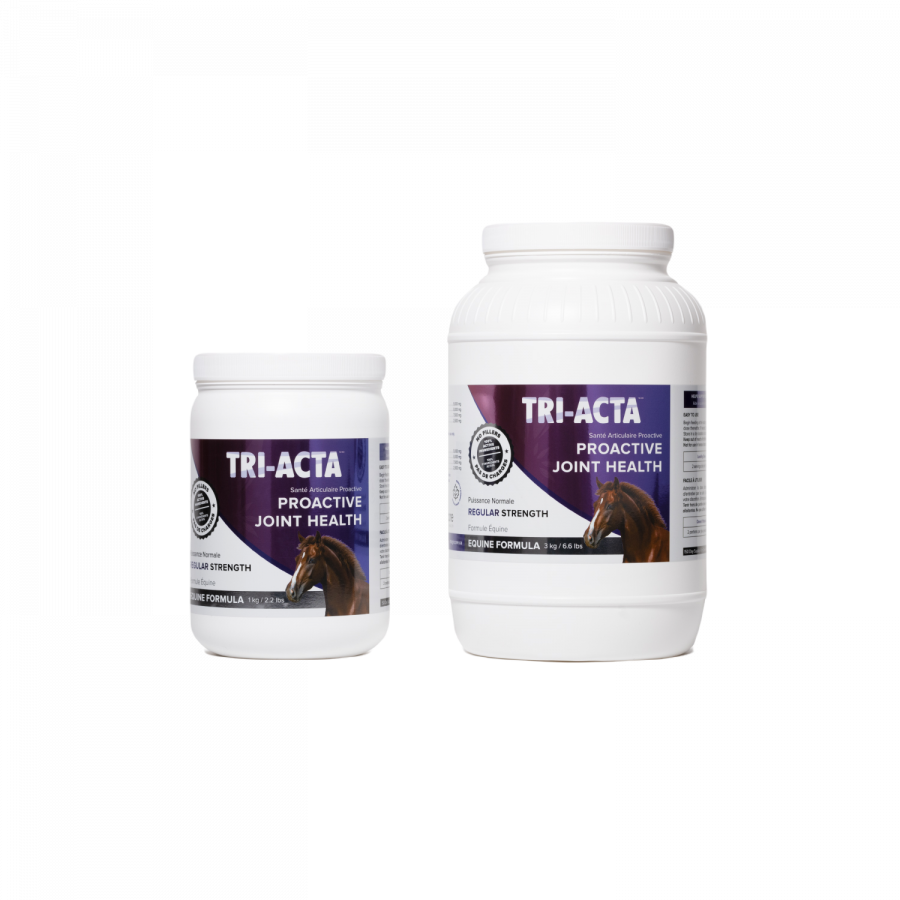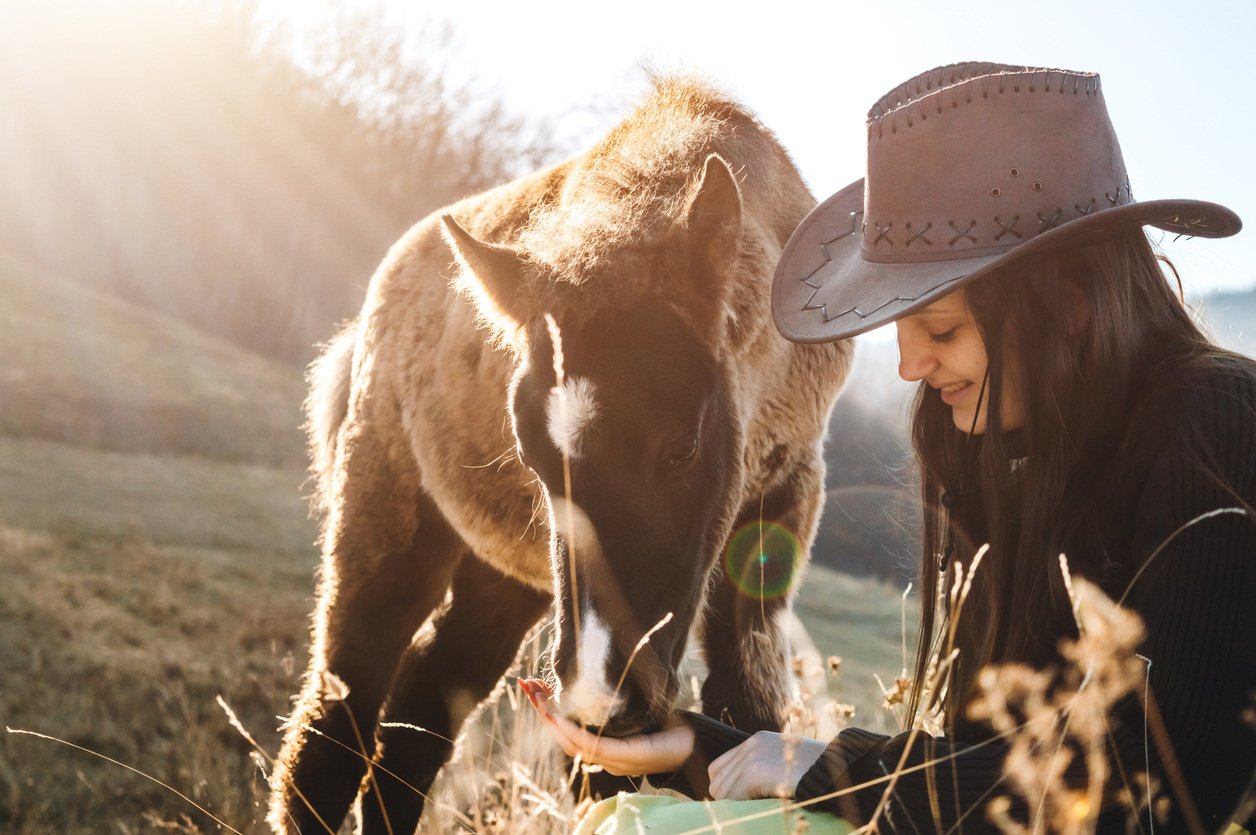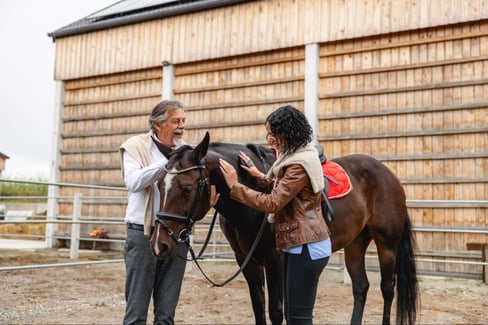Table of Contents
Young male horses, otherwise known as colt horses, should not be confused with the term "foal," which refers to a horse of any sex less than one year of age. Colt horses are males under the age of four, but owners typically call them geldings or stallions as they age.
As younger members of the equine family, colt horses require specialized care to ensure their well-being and prepare them for a fulfilling life ahead.
In this guide, we'll learn the fundamental aspects of colt horse care, covering everything from distinguishing colts from fillies to addressing common health concerns and offering practical training recommendations. Comprehending the distinctions between fillies and colts is vital, as it influences their development trajectories and care routines.
From dietary considerations to exercise regimes and everything in between, each nuance of colt horse care is explored in depth, drawing on expert insights and practical experience.
What Is a Colt Horse?
With a spirited demeanor and vibrant presence, a colt horse expresses the essence of youthfulness and potential within the equine world. If you're wondering, “Is a colt a baby horse?” The answer is yes, a colt is a male baby horse.
Understanding what constitutes a colt horse is fundamental for any equestrian:
- Enthusiast
- Groomer
- Farrier
- Rider
- Trainer
A colt horse is defined as a young male that has not reached maturity yet. They are generally under the age of four and display characteristics of youthful energy, curiosity, and a special keenness to explore their surroundings. During this stage of development, it's essential to care for your companion appropriately to shape their future as strong, capable stallions.
What Is a Colt Horse in Horse Terms
Understanding the different terms used for horses is crucial when navigating the horse world.
Here's a breakdown of some key terms:
- Filly: A young female horse, similar in age to a colt but with distinct female characteristics.
- Yearling horse: A horse that has reached one year of age.
- Foal: A newborn horse, typically within its first year of life.
Each of these terms refers to a specific stage in a horse's development, highlighting horses' unique features and needs at different ages.
Colt Horse Meaning
The colt horse definition extends beyond just the animal's age and sex. It signifies your horse's developmental stage and potential for growth. Colt horses are often delineated by their spirited natures and exuberant demeanor, reflecting the vitality of youthfulness.
Beyond their physical attributes, colt horses evoke a sense of promise and possibility within the equestrian space. These beautiful, powerful creatures represent the next generation of equine athletes, companions, and partners galloping on their learning, training, and discovery journey.
How Old Is a Colt Horse?
Determining the age of a colt horse is essential for understanding its stage of development and potential capabilities. While colts are typically under the age of four, their precise age can vary depending on factors such as:
- Breed
- Genetics
- Individual growth rate
As colts approach age four, they may undergo significant physical and behavioral changes as they transition into young adulthood. At this juncture, they may be called "stallions" if left ungelded or "geldings" if neutered.
Guide to Caring for a Colt Horse
Your colt horse deserves the best, and caring for it is no exception. You can guarantee your horse's long-term well-being by combining attention to detail, regular veterinary check-ups, proper grooming, nutrition management, preventative measures, and more.
This section examines each aspect of colt horse care to provide insight into maintaining your four-legged companion's health and vitality.
Vet Schedule
Taking good care of your colt's health requires regular visits to a qualified equine veterinarian.
This includes:
- Check-ups
- Vaccinations
- Dental care
Schedule a wellness exam soon after bringing your colt home. During this first visit, the veterinarian will thoroughly examine your colt, assess his overall health, and discuss vaccination and deworming schedules.
Follow-up vet visits are crucial and should be scheduled regularly, typically every six months to a year, depending on your colt's age, health, and individual needs. These visits allow for preventive care, early detection of potential health issues, and personalized recommendations for optimal care and management, especially as they become old horses.
Grooming
Regular grooming offers a multitude of benefits for your colt horse. Not only does it enhance his appearance, but it also:
- Promotes healthy skin and coat: Brushing removes dirt, debris, and loose hair, allowing the skin to breathe and distributing natural oils, promoting a healthy and lustrous coat.
- Strengthens the bond between horse and handler: The grooming process provides an opportunity for interaction and builds trust between you and your colt.
- Allows for early detection of potential health issues: Regular grooming allows you to closely examine your colt's body, potentially identifying early signs of skin conditions, injuries, or other health concerns.
Implement a daily colt care and grooming routine. Thoroughly brush your colt's coat to remove dirt, debris, and loose hair. Use a soft-bristled brush or grooming mitt to gently massage the skin and distribute natural oils, promoting a healthy shine.
Beyond brushing, pay close attention to specific areas:
- Hooves: Regularly clean hooves to prevent dirt and debris buildup, which can lead to infections or discomfort.
- Eyes and ears: Regularly check eyes and ears for signs of infection or irritation, such as discharge, redness, or swelling.
- Tail: Gently untangle any knots or debris from the tail to prevent matting and discomfort.
By implementing this meticulous grooming routine, you can significantly contribute to your colt's overall well-being and build a strong bond with your equine companion.
Feed
Proper nutrition is the cornerstone of your colt's growth and development. Consult an equine nutritionist or veterinarian to formulate a balanced diet tailored to your colt's age, size, and activity level.
High-quality hay or pasture should form the foundation of their diet, supplemented with a concentrated feed formulated specifically for growing horses. Ensure constant access to fresh, clean water to support optimal hydration.
Preventative Care: Joint Supplements
As your colt grows and matures, its joints endure significant stress and strain. Incorporating joint supplements into their diet can help promote healthy joint function and mobility, potentially mitigating the risk of future joint-related issues.
Check out our TRI-ACTA for equine, perfect for supporting your colt horse's joints as they grow and mature. Formulated with 100% natural ingredients like two types of glucosamine (HCl and Sulfate), Methylsulfonylmethane (MSM, a natural anti-inflammatory), and Chondroitin Sulfate (helps promote cartilage repair and maintenance), TRI-ACTA is able to provide top joint support for your horse.
Our advanced formula contains active ingredients that work together to:
- Enhance the protective response of joint tissues
- Accelerate the formation of cartilage
- Increase viscosity of synovial fluid
- Reduce inflammation
- Expedite the healing process
If you are uncertain about what horse supplements are most suitable for your companion, contact us or speak to your veterinarian to determine the most suitable supplementation and dosages for your colt horse's specific requirements.
TRI-ACTA for Equine
Providing preventative support for younger horses and helping mitigate the early onset of joint degeneration and other mobility issues.

Distinguishing Care: Colts vs. Fillies
While the journey of nurturing young male and female equines shares numerous commonalities, it demands distinct approaches tailored to their inherent dispositions.
Male youngsters often exhibit a more assertive and spirited mind, necessitating early guidance and socialization to cultivate desirable conduct and discourage unbecoming actions. This proactive approach lays the foundation for introducing a new horse to the herd and caregivers alike.
As these young males approach the precipice of sexual maturity, their burgeoning virility may manifest in behaviors akin to mounting endeavors or assertive exchanges with peers. Addressing these inclinations through consistent tutelage and vigilant oversight is paramount, thus ensuring the well-being and safety of all involved.
Training and Handling
Early, consistent horse training is vital to shape a well-mannered and obedient companion. A reputable trainer can give you advice and guidance while helping to train your companion or performance athlete to become the best version of itself.
Experienced horsemen can also help you establish a solid foundation in ground manners, leading, and basic commands. Remember, positive reinforcement and patience are key to fostering a trusting relationship and responsive colt horse.
Environment and Housing
Like all young animals, colt horses require a well-structured environment that caters to their physical and mental well-being. This includes providing ample space for exercise, opportunities for socialization with other horses, and a safe living space that meets their specific needs.
Young horses are naturally energetic and social creatures. Allowing them to express these natural tendencies is crucial for their health and development.
Preventing boredom can help avoid unwanted behaviors and promote healthy cognitive function.
Let's look at a few mental stimulation techniques to try with your colt horse.
|
Technique |
Description |
Benefits |
|
Interactive Toys |
Provide toys like balls, lick logs, or food puzzles that encourage exploration and problem-solving. |
|
|
Training Sessions |
Engage your colt in regular training sessions that challenge their minds and teach them valuable skills. |
|
|
Turnout with Compatible Horses |
Allow your colt to interact with other horses that are suitable companions. |
|
Creating an enriching, safe environment that caters to both the mental and physical needs of your colt horse significantly contributes to its healthy development over its youthful years.
Health Monitoring
Regularly monitoring your colt's health is crucial for early detection and prompt intervention should any issues arise. Familiarize yourself with the signs of common equine ailments, such as:
- Colic
- Respiratory issues
- Lameness
Observe your colt's behavior, appetite, and overall demeanor for any deviations from their normal patterns. Maintain detailed records of their growth, weight, and any treatments or interventions administered.
Socialization and Companionship
Colts, like all horses, are social creatures and thrive in the company of their peers. Provide opportunities for your colt to interact with other horses, fostering healthy social bonds and promoting natural behaviors.
However, exercise caution when introducing new horses to your colt's herd, gradually acclimatizing them to minimize the risk of aggressive interactions.
Hoof Care
Regular hoof care is essential for your colt's overall soundness and mobility. Establish a routine for professional farrier visits to maintain proper hoof balance and ensure timely trimming or shoeing as needed.
Additionally, monitor your colt's hooves for signs of cracks, thrush, or other issues that may require prompt attention.
Dental Care
Proper dental care is often overlooked but plays a crucial role in your colt's overall well-being. Schedule regular dental examinations and float procedures (filing down sharp enamel points) to ensure optimal digestion and prevent discomfort or resistance during bit acceptance.
Facilities and Equipment
Invest in high-quality facilities and equipment tailored to your colt's needs. Sturdy fencing, secure stalls or shelters, and appropriate feeding and watering containers are essential for their safety and comfort. Regularly inspect and maintain these features to prevent potential hazards or injuries.
Record-Keeping
Keeping accurate and detailed records of your colt's health and development is crucial for several reasons:
- Tracking Progress: Records allow you to monitor your colt's growth, weight gain, and overall health progression over time. This provides valuable insights into their development and helps identify potential issues early on.
- Identifying Potential Issues: By documenting observations and incidents, you can identify early signs of health problems or behavioral concerns. This allows for prompt intervention and ensures timely veterinary care if necessary.
- Continuity of Care: Maintaining comprehensive records facilitates communication with your veterinarian. This ensures a complete picture of your colt's health history, enabling the veterinarian to provide the most informed care and advice.
Here are some key details to document in your colt's records:
|
Record Category |
Description |
Example |
|
Growth Measurements |
Height, weight, and other relevant measurements are taken at regular intervals. |
Height measured at the withers every 3 months, weight recorded every 6 months. |
|
Vaccinations |
Dates, types of vaccines administered, and any reactions observed. |
Tetanus vaccination was administered on [date], and no adverse reactions were observed. |
|
Deworming Schedule |
Dates and types of dewormers used. |
Dewormed with [product name] on [date]. |
|
Observations & Incidents |
Any notable observations regarding your colt's health, behavior, or unusual occurrences. |
I observed mild lameness in the left hind leg after turning out with other horses on [date]. I contacted the veterinarian for a consultation and added a joint supplement to the feed. |
When you diligently maintain accurate colt records, you gain valuable insights into their health and well-being, allowing you to provide the best possible care and ensure their optimal development.
Young Horse Health Issues to Watch Out For
Caring for the horse health of a young colt is a journey that demands unwavering dedication to their well-being. Their formative years present unique challenges that, if left unaddressed, can have long-lasting consequences on their growth, development, and overall health.
Vigilance is key, as ensuring optimal development in these early stages lays the foundation for your equine companion's healthy and fulfilling life.
Once you're equipped with the knowledge necessary to identify and address the most prevalent health concerns that may arise, you can give your colt horse the appropriate treatment.
Here's a table outlining the various health issues that may afflict a young horse, along with their associated signs, symptoms, and potential consequences.
|
Health Issue |
Potential Signs and Symptoms |
Consequences if Left Unaddressed |
|
Nutritional Imbalances |
Stunted growth, developmental delays, poor body condition, metabolic disorders, immune system deficiencies |
|
|
Musculoskeletal Problems |
Angular limb deformities, lameness, swelling in joints or legs, abnormal gait or movement |
|
|
Respiratory Ailments |
Coughing, nasal discharge, labored breathing, lethargy, fever |
|
|
Gastrointestinal Disturbances |
Colic symptoms (pawing, rolling, lack of manure production), diarrhea, weight loss, decreased appetite |
|
|
Parasitic Infestations |
Poor body condition, dull coat, lethargy, diarrhea, colic symptoms |
|
|
Dental Issues |
Difficulty chewing, weight loss, abnormal mouth odor, resistance to bit acceptance |
|
|
Behavioral Challenges |
Aggression, fear responses, stereotypies (repetitive behaviors), undesirable habits |
|
|
Infectious Diseases |
Fever, lethargy, nasal discharge, coughing, neurological symptoms (depending on disease) |
|
By familiarizing yourself with the potential health issues outlined in the table, you can implement proactive measures to safeguard the well-being of your young horse. Regular veterinary check-ups, appropriate exercise regimens, and a balanced diet tailored to their specific needs can go a long way in preventing or mitigating many of these concerns.
How to Train a Colt
The journey of training a colt demands unwavering patience, consistency, and a deep understanding of its unique nature. These young male equines possess a spirited energy that can blossom into a magnificent partnership built on trust and mutual respect when harnessed and channeled appropriately.
The formative years of a colt's life are crucial in shaping their future behavior and temperament. It is essential to begin training early, as this period presents a critical window for instilling desirable habits and fostering a positive relationship with humans. Early socialization and gentle handling not only promote trust and confidence but also facilitate smoother transitions into more advanced training stages.
When training a colt, patience and positive reinforcement should be the cornerstone of your approach. These intelligent creatures respond best to consistent, reward-based methods that encourage desired behaviors rather than punishing undesirable ones. Celebrate even the smallest victories, and remain steadfast in your commitment, for the rewards of a well-trained and willing equine partner are immeasurable.
The training process for a colt should follow a structured, progressive path that builds upon each milestone achieved. The following numbered list outlines the key stages in this journey, providing a roadmap for shaping a well-mannered and responsive companion:
- Ground manners: Establish a solid foundation by teaching basic ground manners, such as leading, standing still for grooming and tacking, and responding to voice commands. These fundamental skills lay the groundwork for future training endeavors.
- Desensitization: Gradually expose your colt to various sights, sounds, and experiences in a controlled and positive manner. This process helps to build confidence and prepare them for novel situations they may encounter in their future roles.
- Lungeing and long-lining: Introduce your colt to lungeing and long-lining techniques. These techniques allow you to control your colt's movement and direction while promoting balance, suppleness, and responsiveness to your aids.
- Biting and saddling: Acustom your colt to the sensations of a bit and saddle, gradually increasing their tolerance and acceptance through positive reinforcement and patience.
- Mounting and dismounting: Teach your colt to stand calmly for mounting and dismounting, establishing a foundation for safe and confident riding sessions.
- Under saddle work: Once your colt is comfortable with the previous stages, begin introducing them to the weight and movement of a rider, initially at the walk and progressing to trot and canter as their fitness and confidence allow.
- Specialized training: Depending on your intended discipline or purpose, introduce your colt to specialized training techniques, such as jumping, dressage movements, or specific ranch or trail skills.
While this list provides a general guideline, tailoring your training approach to the individual colt's temperament, learning style, and progress is essential. Some colts may require more time and repetition at certain stages, while others may advance more quickly. Remain flexible and responsive to your colt's needs, adjusting the pace and methods as necessary to ensure a positive and productive learning experience.
The environment in which you train your colt plays a crucial role in their overall development and responsiveness. Ensure that the training area is free from unnecessary distractions and potential hazards, allowing your colt to focus solely on the tasks at hand. Incorporate variety and mental stimulation into your training sessions to prevent boredom and maintain your colt's engagement.
Training a colt is a journey that requires consistency and collaboration among all handlers involved. Establish clear communication and align training methods and goals to ensure a cohesive approach. Consistency in aids, commands, and expectations will facilitate smoother learning and prevent confusion or conflicting signals for your colt.
While the training may present challenges and require perseverance, it is also a journey filled with immense rewards. Celebrate each milestone achieved, for they strengthen the bond between you and your colt horse.
Revel in the profound connection that blossoms as you navigate this odyssey together, shaping a magnificent equine partner and forging memories that will last a lifetime.
Colt Horse—Final Thoughts
The odyssey of nurturing a young colt horse demands an unwavering commitment to their well-being and a comprehensive understanding of their needs. These spirited beings, brimming with vitality and potential, require a tailored approach that mixes patience, vigilance, and a profound appreciation for their unique dispositions.
While the path may present challenges and necessitate perseverance, it is a journey abundant with profound rewards. Each milestone achieved, each hurdle surmounted, strengthens the profound bond between you and your equine companion.
Embrace the responsibility of stewardship, for in your capable hands rests these magnificent creatures' future vitality and soundness. Approach this undertaking with an open heart, a steadfast spirit, and an unwavering dedication to optimal growth and development. In doing so, you not only nurture the physical well-being of your colt but also cultivate a profound connection that transcends mere ownership.
Preventing joint issues in your horse can mean the difference between them having a high quality of life as they age. A joint supplement like TRI-ACTA can be given to your colt horse from a young age, providing many benefits as they grow:
- Supports proper development of joints as the horse matures
- Reduces the chance of your colt developing joint issues later in life due to enhanced joint support
- Helps prevent lameness and other issues once the horse grows up and becomes a senior equine
Prevention is key to keeping your horse's joints healthy and pain-free throughout their lifetime, and this can be achieved with TRI-ACTA.
Purchase TRI-ACTA online or learn where to buy at a store near you.
TRI-ACTA for Equine
Providing preventative support for younger horses and helping mitigate the early onset of joint degeneration and other mobility issues.

Newsletter Signup
Subscribe to our newsletter to receive the latest news and exclusive offers.
.jpg?height=2000&name=Cliick_Integricare-DISPLAY-REVISEDV2%20(1).jpg)
Proactive & Therapeutic Joint Supplements
When given daily, Integricare joint supplements recover bone and joint injuries faster and help prevent mobility injuries from happening in the first place.











